So, what is an action portrait? An action portrait shows emotion in motion. It’s a photograph that delves deeper than the surface of a person’s face, and tries to show who the person really is. By portraying emotional expression, action portraits try to show a person’s “being” and their “doing.”
From start to finish, the process of making action portraits should be approached with enthusiasm and energy.
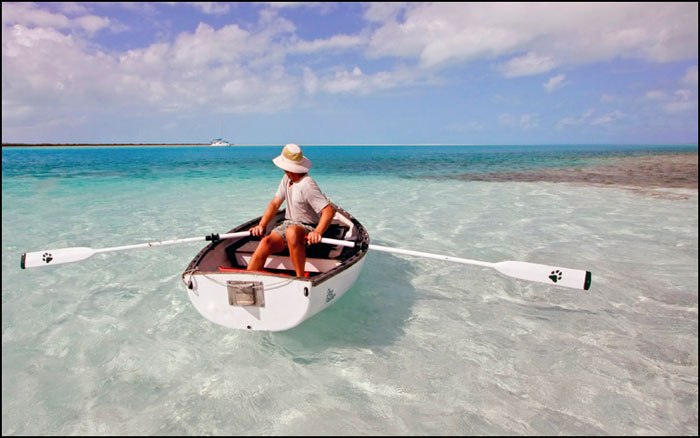
Go Wide from Far Away: Creating a Sense of Place
Wading waist-deep in a strong salt water current near a mangrove-covered island in the Bahamas, I took this portrait of a man rowing. With a wide angle lens mounted on the camera, I took several frames from slightly different positions, making small changes in camera position with each new attempt.
Raising the camera lowered the horizon line, and changed the distance between the rower and the horizon. Once I find a good position, I stand firm, and try to keep the camera as solid and unmoving as possible.
Because the angle of the rowboat oars leads us to the subject and his gaze leads us back to a boat on the horizon line, the composition of this image keeps the viewer’s eye moving. The composition comes together when the camera is positioned at the right distance and viewing angle from the subject.
PHOTO TIP:In order to find the right distance from the subject, you may need to move back and put more distance between the camera and the person in your portrait.
As photographers we can also attempt to see the person in the scene as a compositional element. What does this mean? It means that their form and the place they fill in the frame should harmonize with the photograph’s overall composition. The result is an action portrait with an atmosphere, because intriguing action portraits often give a sense of movement and a sense of place.
Charisma: Lighting the Human Experience
Well-crafted action portraits also involve lighting and emotion. The humanity we see in a portrait, not the technology that a photographer used to make it, is the reason we view it with interest.
To create these portraits, we must depict a person’s inner or outer expression. Even when someone is just standing or sitting, a portrait of them becomes an action portrait if it portrays their charisma, like the photograph of the blacksmith in his forge.
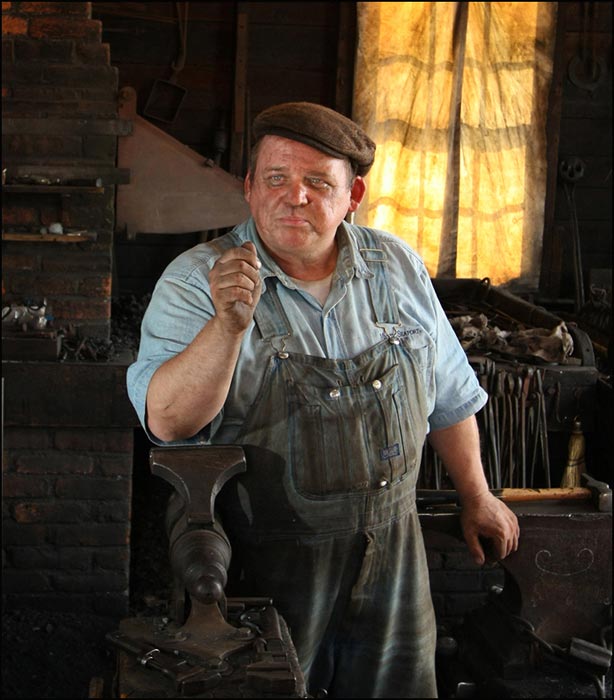
Effective photographs of people inspire us to think beyond our digital techniques to aesthetics; that is, the beauty within a portrait. The essence of an action portrait is emotion, not the latest camera or lens technology. The image itself is more artistic when we can see the character and spirit of a person’s face. This is a quality that technology cannot give a photographer.
A blend of camera technique with the spirit of the subject is intriguing when an empathetic photographer shows us the humanity shining in a person’s face. This humanity comes from emotional expression. To make better action portraits, photographers should have an awareness of their subject’s personality and emotions.
For instance, to show his emotional intensity, I photographed Craig, a blacksmith, from a little to his left side, and lit his face so that his left side was brighter.
Why? If you are a right-handed person, the left side of your face is often the emotionally expressive side. Ask someone to share their emotions, and they will usually show you the left side of their face. The reverse is true for “lefties” too.
Sharper Action Portraits: Faster Shutter, Higher ISO
Unlike portraits in a studio, camera and subject may each be moving, joining together for one small slice of time. Most of the time, we want to stop the action. Choosing to create blur in an action portrait is a viable option, but first let’s look at methods for making sharply focused, motion-freezing portraits.
To take sharper action portraits, we have to know something about camera settings. You can make action portraits with the camera set on P, or Program. We call this Pro mode, because Pros use it too. However, for fast capture, choose Shutter Priority and set a shutter speed that is faster than you might think to use.
Note: Shutter priority can be labeled Tv or S, for Time Value or Shutter Priority, on camera mode dials.
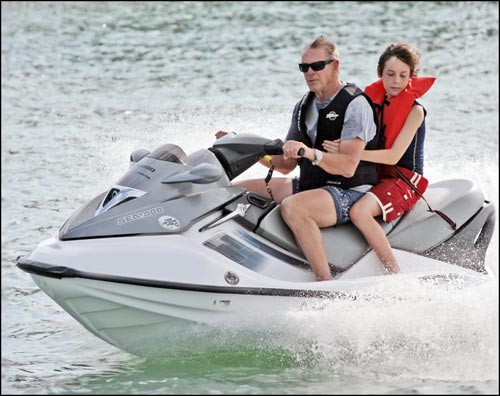
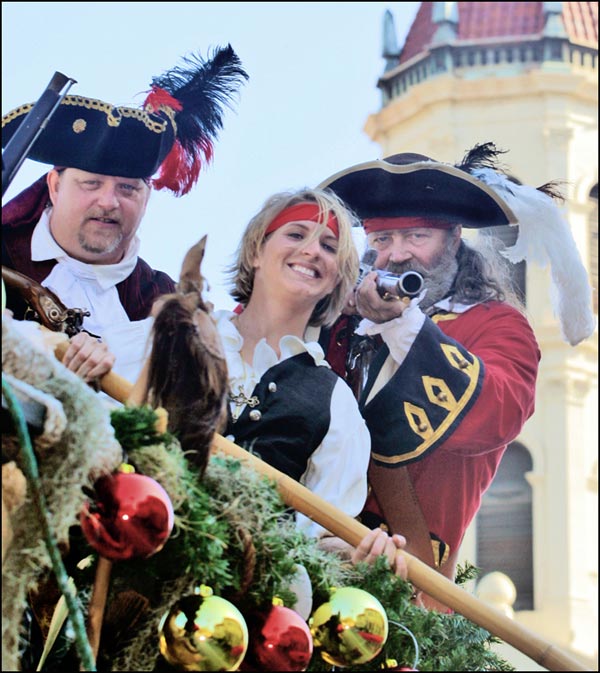
Here is an example: I set the shutter speed to 1/1500th of a second for the jet ski image to freeze the action. Let’s stop to think about how we get faster shutter speeds.
Exposure depends on 3 things: camera sensor sensitivity, aperture opening of the lens, and how long the shutter is open (shutter speed). A higher ASA/ISO makes the sensor more sensitive to light. ISO used to mean a greater sensitivity of film to light. In the digital age today, ISO is an approximate measure represents the camera chip’s sensitivity.
Because dialing in a higher ISO in your camera’s mode dial makes the sensor more light sensitive, the time required for the shutter to be open can be shorter, so we can set faster shutter speeds.
Fast ISO settings from 1600 to 25,600 (Nikon’s D3 and D7000) and up allow for much faster shutter speeds. For instance, the shutter speed for this jet ski image was 1/1500th of a second, short enough to freeze the water drops.
Directing Subjects: Keep it Simple
For this photograph of parading pirates in Florida, I chose a medium telephoto lens with a large aperture. Earlier that day, I walked the street and searched for just the right position from which to photograph. During the parade, I yelled up to the pirates to get their attention and have them to look my way.
When you are close enough to your subjects, all you have to say to them is, “Look at Me.” It also helps to point to your lens if your voice is not louder than the chorus of a parade. Either way, you can successfully direct your subject to look in your direction.
PHOTOGRAPHERS TIPS: Keep in Mind 4 Basic Concepts
1. Identify and Simplify your background.
2. Know the depth of field intimately for any aperture of your lens.
3. Take many frames, think in between frames, stay with your subject and don’t give up early.
4. Choose where you stand to let the main light come from a useful direction, then add lighting (strobe, fill, reflectors) to balance this light.
Go Wide, Up Close: Portraying Personality
Ra and I talked outside on the Lincoln Road Mall in Miami Beach, Florida. The picture of him extends the idea of an action portrait because the action is his personality, as he paused to make a point.
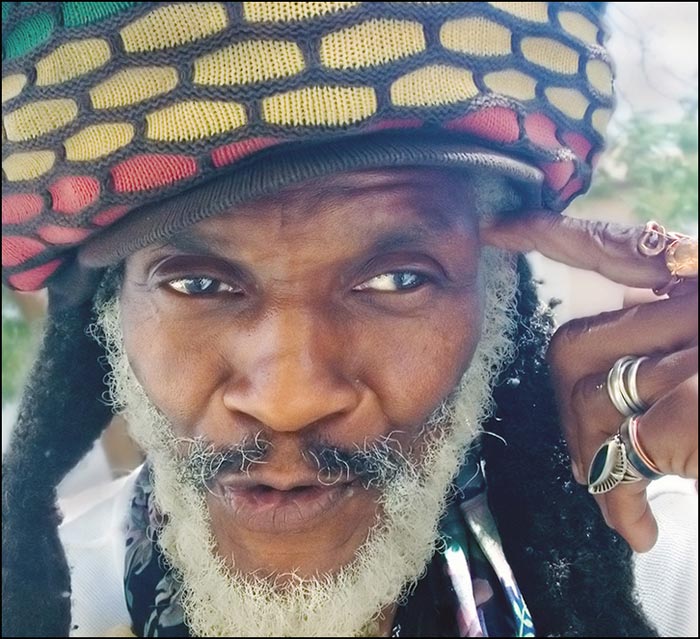
Traditionally, photographic portraits are made with a lens with a focal length of about 70 mm or longer. When we choose a wide angle optic instead, action portraits can be a challenge. Why? A wide angle lens stretches the distance between foreground and background, so objects close to the camera appear huge and things in the background almost disappear from view.
The wide angle lens I used for Ra’s portrait has more distortion than normal focal length lenses.
Up close, one way to make wide angle distortion less apparent is to keep the subject close to the middle of the frame, as this tends to minimize some wide angle distortion. I also correct distortion with lens correction in Lightroom 3’s Develop Module.
The benefit of using a wide angle lens, however, is that its perspective invites us to make close-ups of the person we are portraying. I believe making portraits with a wide angle is a good experience all around, because the lens compels me to get closer to my subject and start a conversation.
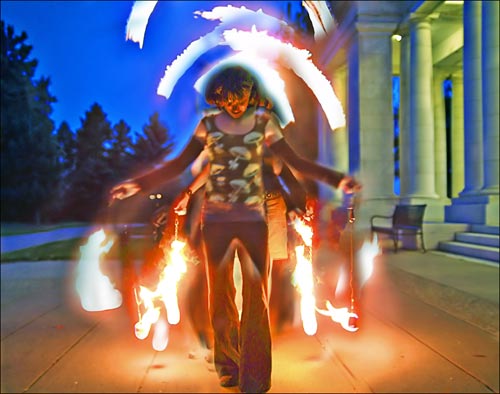
Catching the Flame: Low Light and Motion Blur
At times a more expressive portrait comes from using blur. Deliberate blur can capture the motion of a dance or a performance. After making a series of exposures of the fire twirling that two women were doing at night, I layered the images together in Photoshop. Earlier we looked at techniques for sharp portraits, but the vision here was to show action through blur.
Fluorescent light from a building at right, plus burning torch light combined together to illuminate the picture, called “Catching the Flame at Dusk.”
While some of us learned we should photograph only in the golden hours of good light, digital photographers today must learn to have flexible, open minds about lighting. With today’s camera sensors we can photograph in any light, and make grain and motion blur our friends.
The high ISO settings sometimes required for low light shooting cause sensor noise. This noise is not a mistake, but a natural part of the limits of some camera sensors for low light photography. Learning to use software to reduce noise, and choose a level of grain appropriate for your subject, is a helpful skill.
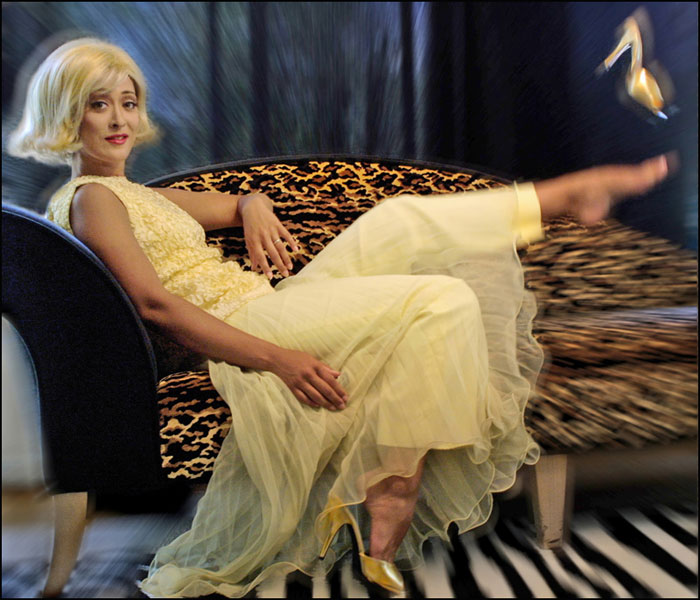
by Jim Austin
All text and photos: © 2011 Jim Austin. All rights reserved.

Leave a Reply